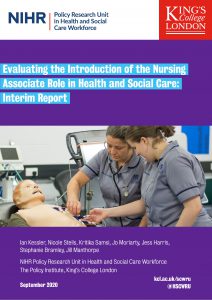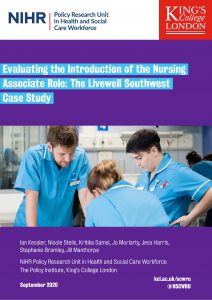Ian Kessler is Professor of International HRM at King’s Business School and Deputy Director of the Policy Research Unit in Health and Social Care Workforce (HSCWRU). Prof Kessler is lead author of the Interim Report and two case studies from the HSCWRU Nursing Associates study, published today. (1,624 words)
Film of webinar (23/11/20) where Prof Kessler discussed these findings.
We are conducting a survey of senior health and social managers on the use and management of the nursing associate role. The survey is open until 18 December 2020.
The introduction of the Nursing Associate (NA) role in England represents a decisive step towards changing the structure of the nursing workforce, with a view to improving the quality of health and social care. Originally proposed by the 2015 Willis report on nurse and care assistant education[1], as ‘a bridging role’ between the care assistant and the registered nurse, the NA has emerged in NHS England as a pay band 4 role, requiring a two-year level 5 qualification, registered with and regulated by the Nursing and Midwifery Council (NMC). The NA programme was launched in early 2017 in two waves 11 pilot and 14 ‘fast follower’ sites, respectively taking-on 1,000 Trainee Nursing Associates (TNA). There were subsequent waves, with 5,000 TNAs recruited in 2018 and 7,500 in 2019. It is a role which attracts interest given its capacity to address a variety of workforce and care management goals. However, as with the introduction of any new role, there are organisational challenges to be faced in ensuring that it becomes established at the workplace level and accepted by the various actors with a stake in it, including nurses, managers, healthcare assistants and service users.
Over the last eighteen months, we have been exploring these issues. The first phase of the evaluation centres on the initial waves of 2,000 NAs, now largely qualified and registered, with a particular interest in how they have been viewed, deployed and managed, and drawing on three primary data sources:
- A programme of around forty expert interviews with policymaker, practitioners and commentators across health and social care;
- A survey of Chief Nurses in NHS England, generating responses from over 100 Trusts, around half of whom employ early wave NAs; and
- Two detailed case studies[2]: Livewell Southwest and Cambridgeshire and Peterborough Foundation Trust (CPFT), both providing community and mental healthcare services.
The full findings are presented in three reports (two case study reports and an Interim Report, which covers the expert interviews and survey) posted on the Health and Social Care Workforce Research Unit site. This Blog provides an overview of the key findings in three parts: NA role objectives, benefits and challenges.
The new NA role is striking in the range of policy objectives underpinning its introduction. While initially designed as a ‘bridging’ role of value in its own right, the NA has also been viewed by policy makers and practitioners as a means of: supporting the delivery of more generic, person-centred forms of care; encouraging partnership working between care providers at systems level; allowing nurses to delegate more routine tasks with confidence, so freeing them up to concentrate on more complexes cases; and contributing to the development of career pathways, not least into registered nursing.
The value of the role in these terms was reflected in our Chief Nurse survey confirming that Trusts were employing NAs in pursuit of multiple objectives. Thus, over three quarters of our respondents attached ‘considerable importance’ to the role as a means of: growing-their-own nurses; freeing-up nurses; and providing career development opportunities, especially for their healthcare assistants (HCAs). As a senior manager in the Livewell case stated, ‘We have a wealth of people who are fantastically compassionate and caring, and what they probably haven’t done is gone through that traditional education route and got that qualification to support it, so we really wanted to focus on having that career pathway for our healthcare support workers’. Indeed, asked to prioritise objectives, by far the most commonly cited reason for employing NA, amongst surveyed Chief Nurses, was ‘growing their own nurses’. As one of expert interviewee noted, ‘If you look at the widening participation debate, it’s (the NA programme) probably one of the best models of widening participation we’ll ever see.’
The inevitable challenges of introducing a new health and social care role were deepened by a degree of uncertainty about the form the NA role would take: as the first sites launched, the NMC was still developing the NA standards of proficiency. Moreover, for non-registered assistant practitioners (APs) also sitting at pay band 4 with a level 5 qualification, the NA role unsurprisingly caused some personal anxiety, although our survey suggested than many Trusts employing NAs were still keen to retain the AP as a senior support role in the allied health professions. The initial uncertainty about the NA role perhaps accounts for the surveyed Chief Nurses viewing the integration of NAs into established ways of working within the nursing teams as the main challenge faced. This challenge was apparent in our case study Trusts, and captured by a NA at CPFT noting ‘The most frequent question I got asked for a long time was, ‘can you do that?’ From our case studies, it was clear that the scope of NA practice was developing incrementally as co-workers and managers gradually shaped and engaged with the role. Indeed, well over a half of the surveyed Chief Nurses attached ‘considerable importance’ to the challenge of gaining acceptance for the NA role from registered nurses and, to lesser extent, from HCAs and services users.
The challenges faced should not detract from the benefits already emerging from the role. As a senior nurse manager at CPFT noted, ‘The feedback that we’ve had across the board is that people like the role.’ Certainly, with NAs still employed in small numbers in any given Trust, and typically found in ones or twos in any given ward or team, there was limited scope to assess the role’s direct impact on care quality. Moreover, with NAs found in a wide range of clinical settings- in our cases, in-patient mental health wards, district nursing and health visiting teams, liaison psychiatry, complex needs and outreach teams- the benefits derived from the role were often context specific.
In general, however, various benefits were highlighted. First, in process terms, the development of TNA pilot sites, often mapping onto Sustainability and Transformation Partnerships (STP), and comprising coalitions of providers organisations, represented an opportunity for shared working at the system level. As an expert interview noted, ‘Partnerships working (around the NA role) was one of the first workforce things where you saw a tangible STP type of approach.’ At both CPFT and Livewell, partnership working with the other NA employers in their catchment area led to the development of shared NA job descriptions, handbooks, uniforms and placement opportunities, with a view to establishing the NA role as a system rather a single provider resource.
Second and more substantively, there were signs of the NA scope of practice broadening. This was facilitated by the fact that many of the qualified NAs were already known and trusted by the other staff members, having formerly worked in the team as an HCA. Within various types of community teams, particularly district nursing, NAs were being allocated and taking greater responsibility for the management of less complex cases. This allowed the registered nurse to spend more time on patients with more challenging needs, while the NA was in position to provide close and continuous care to their patients. With the appropriate training and clinical governance protocols, NAs were also administering a greater range of medicines in diverse care settings. Moreover, NAs were playing an increasingly direct and assertive role in handovers, multi-disciplinary teams meeting and ward rounds, while taking on certain leadership roles, for example in mentoring and supervising HCAs, and acting as the Duty Nurse on a shift.
Third, the NA role was providing a firm stepping-stone into registered nurse training. The overwhelming majority of qualified NAs in our case study trusts had already, or were keen to move as swiftly as possible, into such training: for some this had always been the plan; others had gained a confidence in their capacity to learn during their NA training, which encouraged them to move straight into nurse training. Given the weight placed by surveyed Chief Nurses on grow-your-own, it is interesting to note some concern in the case study Trusts at this rapid throughput of NAs onto nurse training. From an organisational perspective, it was felt the establishment of the NA role, as a valued position in its right, might be undermined by such a rapid throughput, while from an individual development perspective, there was a perceived danger that newly qualified NAs were not taking the necessary time to consolidate or apply their newly acquired skills. As a nursing manager at Livewell noted. ‘It’s a bit of a double-edged sword. We are producing people that we want to stay in the (NA) role, which is brilliant, but actually we’re training them to leave us, and we are constantly struggling with that.’
Our plan to undertake further case study work on the introduction of the NA role, particularly in acute Trusts, was interrupted by the Covid pandemic, limiting our understanding of the take-up and implementation of the NA role in this setting. We intend, nonetheless, to continue with our evaluation, repeating our expert interviews as a means of exploring how the role- its deployment and management- have fared during this time of crisis. It is already clear from our research that the NA role is beginning to address both workforce pressures and care needs in health and social care. At the appropriate time, we are keen to re-start our evaluation to explore how it might continue to do so in this difficult period.
Ian Kessler is Professor of International HRM at King’s Business School and Deputy Director of the Policy Research Unit in Health and Social Care Workforce.
Film of webinar (23/11/20) where Prof Kessler discussed these findings.
We are conducting a survey of senior health and social managers on the use and management of the nursing associate role. The survey is open until 18 December 2020.
The Interim Report published today
Kessler, I., Steils, N., Samsi, K., Moriarty, J., Harris, J., Bramley, S., & Manthorpe, J. (2020). Evaluating the Introduction of the Nursing Associate Role in Health and Social Care: Interim Report. London: NIHR Policy Research Unit in Health and Social Care Workforce, The Policy Institute, King’s College London.
The two case study reports published today
Kessler, I., Steils, N., Samsi, K., Moriarty, J., Harris, J., Bramley, S., & Manthorpe, J. (2020). Evaluating the Introduction of the Nursing Associate Role: The Cambridgeshire and Peterborough NHS Foundation Trust Case Study. London: NIHR Policy Research Unit in Health and Social Care Workforce, The Policy Institute, King’s College London.
Kessler, I., Steils, N., Samsi, K., Moriarty, J., Harris, J., Bramley, S., & Manthorpe, J. (2020). Evaluating the Introduction of the Nursing Associate Role: The Livewell Southwest Case Study. London: NIHR Policy Research Unit in Health and Social Care Workforce, The Policy Institute, King’s College London.
Nursing Associates project page at HSCWRU.
References / notes
[1] Health Education England (2015) The Shape of Caring: Raising the Bar, London: HEE
[2] These case studies were based on a programme of interviews with key organisational stakeholders: NAs, TNAs, ward/team managers, registered nurses, HCAs and senior Trust managers. Plans to return to the cases to explore patient views on the role were put hold in the light of Covid.


